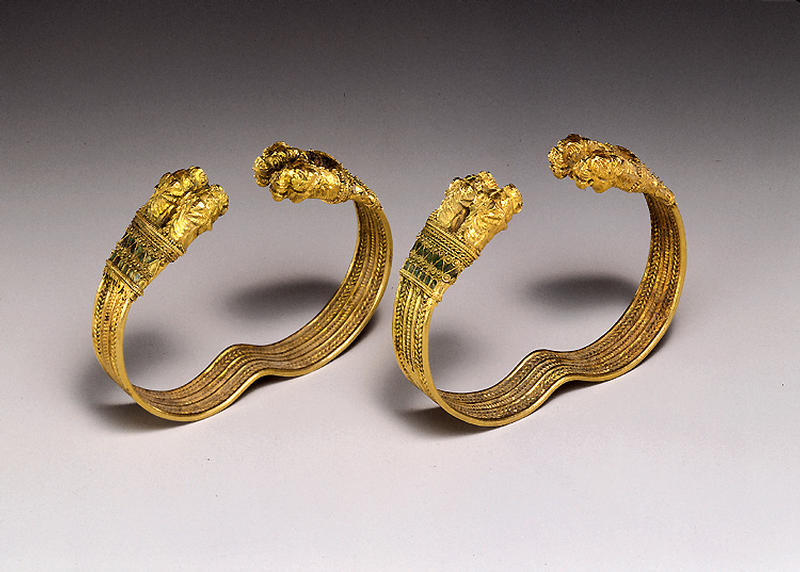Pair of Bracelets with Double Lion's-head Terminals
- Iran
- Persia, Achaemenid period
- Possibly 4th century B.C.
- Gold with cloisonne inlay and vitreous paste
- H-4.5 W-6.2
Catalogue Entry
This second pair of lion's-head bracelets repeats some features of the first (cat. no. 42) but enhances them with a much more elaborate design and a much higher quality. The circlets are doubled and so is the pair of lion's-heads.1 The Persian prototypes of our lions are still visible in the ornamentally stylized eye sockets, in the idea of a carefully combed mane on the neck, and in the shape of the huge ears; but the refined elegance of the Achaemenid prototypes is almost entirely lacking.
The superb craftsmanship displayed on the cuffs behind the animal's heads indicates, however, that the difference is more a question of style than of quality. The antithetical ornamental volutes on the cuffs are bordered by tiny tongs and decorated with inlays of colored paste, a technique widespread among Graeco-Persian Black Sea jewelry.2 The lyre-like motif is clearly a simplified version of a Greek element that can be traced on a considerable number of animal-headed bracelets of Greek or at least Hellenized workmanship which span not only the late Achaemenid period but reach into the early Hellenistic age.3
For a cultural attribution, we should place our second pair in the same setting of a hypothetical Graeco-Persian workshop tradition within reach of the Black Sea as suggested for the first lion-headed pair. The use of the characteristic Asiatic indentations in the circlets of both pairs is heretofore unknown among Northern Pontic jewelry, and in view of the references to Achaemenid details on the lion's heads, an attribution to an Asia Minor workshop of the fourth century B.C. seems to be most appropriate.
MP
1. For an example with multiple heads on each terminal of the circlet see a bracelet with alleged Luristan provenance with six confronted lion's heads in Paris, Louvre AO 20136: Godard 1950, p. 52, fig. 43; Parrot 1953, p. 9, pl. 6. For Graeco-Persian bracelets from Greek ateliers with just two animals but double rings see Pfrommer 1990b, pp. 118-19, TA 124, 125, fig. 16.4; pl. 21.2 (St. Petersburg, Hermitage BB 35.36 and BB 77.78, from the "Great Blisniza" in the Taman Peninsula).
2. For this technique see Piotrowski, Galanina, and Gratsch 1986, figs. 122, 127, 133, 134, and so on.
3. For the motif see Pfrommer 1990b, pp. 101, 107, 117-18, 282 TA 73, pl. 17.3, and p. 413 (index, s.v. Rankenleier). The only bracelets found in the Achaemenid heartlands showing this detail is a pair of Graeco-Persian style from Iranian Pasargadae: Stronach 1978, p. 168, no. 1; p. 174, fig. 85.4, pl. 146d-147f; Pfrommer 1990b, pp. 98-99, TA 162, fig. 16.38. For Pontic versions of the S-shaped volutes see Piotrowski, Galanina, and Gratsch 1986, figs. 175, 177 (upper frieze).
